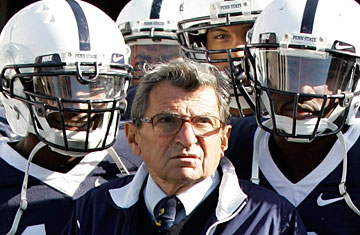
In this Oct. 13, 2007, file photo, Penn State head football coach Joe Paterno stands with his team before their NCAA game against Wisconsin in State College, Pa.
(2 of 2)
All the while, Paterno conducted what he called the "Grand Experiment": he was convinced that athletes could, in fact, also be good students. "In an era of college football in which it seems everybody's hand is in the till or balled up in a fist, Paterno sticks out like a clean thumb," Sports Illustrated wrote in its '86 Sportsman of the Year profile. "His standard of excellence is so season-in, season-out consistent it borders on the monotonous: win 10, 11; send off another bunch of future doctors, lawyers and accountants." Penn State's football-player graduation rates remain consistently above the norm. In December, the New America Foundation gave Penn State the highest academic rating of all the top schools playing in major bowl games. Paterno quoted the classics in his pregame speeches and assigned book reports to his recruits. "Football isn't everything," he told TIME in 1978. "It's just another extracurricular activity, like science club or the band."
The life-size bronze statue of Paterno outside Beaver Stadium, where Penn State students gathered Sunday to mourn his passing, symbolized Happy Valley's reverence and adoration for "JoePa." Paterno and his family donated over $4 million to the university for faculty positions, an interfaith spiritual center and the Mount Nittany Medical Center. In 2000, Penn State named a library after the noted bookworm.
Even before the Sandusky scandal broke, however, Paterno was not immune to critics who wondered if the game had passed him by. Over the past 15 years, Penn State has rarely appeared in college football's national-championship picture. In 2005, university officials asked Paterno to step down, but he stubbornly refused. And in recent years, the program has not always reflected the saintly image of its coach. A 2008 investigation by ESPN revealed that in the previous six years, 46 Penn State football players had faced a total of 163 criminal charges. Paterno called the report a "witch hunt." According to a Wall Street Journal story that appeared after the Sandusky story broke, Paterno thwarted efforts by the school's standards-and-conduct officer to discipline football players for, among other transgressions, beating up other students. Paterno, according to the story, threatened to stop fundraising unless the Penn State official, who later resigned, was fired.
Paterno said he did not retire earlier because he feared facing the same fate as legendary Alabama coach Bear Bryant: only a month after Bryant retired, he died of a heart attack. Paterno loved football, and Penn State, so much that he suspected he would literally die without the Nittany Lions in his veins. It was a premonition that proved eerily true. But no one saw him dying as a tragic figure.